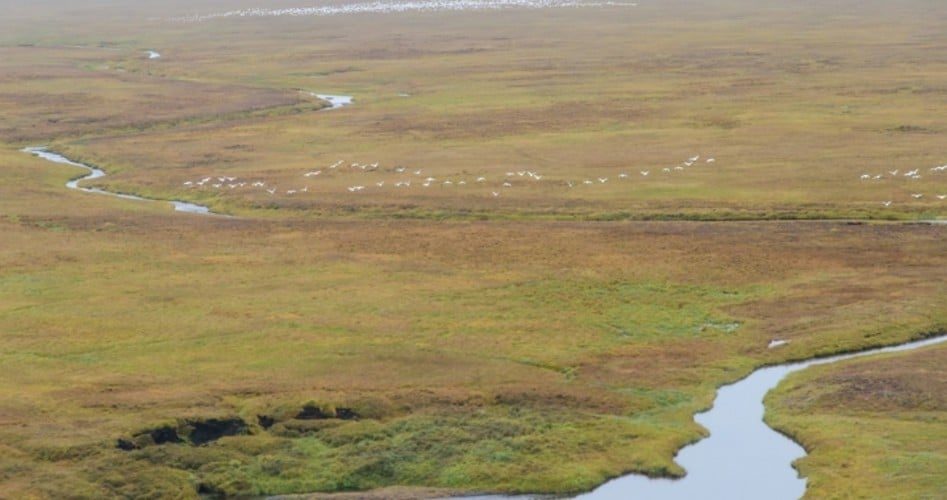
On Sunday, mega-bank Goldman Sachs announced major restrictions on its loans to energy developers, especially those seeking to exploit the resources beneath the Arctic National Wildlife Refuge (ANWR). The restrictions apply across the entire energy sector and include loans to develop coal mines and finance coal-fired power plants.
It was just a matter of time, as environmentalist groups have pressured Goldman and other big banks for years to cut their funding to any entity seeking to develop fossil fuels. Jason Opena Disterhoft, a senior official at Rainforest Action Network (RAN), a group whose motto is “environmentalism with teeth,” said Goldman’s move is just the first of many to be announced: “The smart money on Wall Street is drawing red lines on oil and gas, and [is] exiting coal [development]. The big money has to respond, or it will be left holding the bag.” And then Disterhoft targeted JPMorgan: “Over to you Jamie Dimon and JPMorgan Chase.”
Goldman concluded three years earlier that development costs in ANWR were just too high to justify its development: “We think there is almost no rationale for Arctic exploring.… immensely complex, expensive projects like the Arctic we think can move too high on the cost curve to be economically doable.” Now they have the “green” excuse to back up their position. It’s called the “ESG movement” — environmental, social, and governance — and its influence is gaining traction.
The bank’s decision is putting additional pressure on energy developers, especially those using fracking technologies. Those developers have poured billions into the new technology to wring additional production from existing wells and expand the development of rich reserves in the Bakken, Permian, Eagle Ford, and other fields.
They have single-handedly quadrupled U.S. oil and gas output since 2014, from five percent of global output to nearly 20 percent, making the United States a net exporter of energy for the first time in decades.
But profits have been elusive, and investors are tiring of waiting for a return on their money. They are pressuring developers to start turning a profit and begin paying some dividends.
Part of the problem is inherent in the fracking process: Output from a newly developed well drops precipitously, often by as much as 70 percent, over the first year. This forces developers to continue drilling, resulting in a non-stop “treadmill” that’s required to maintain production.
Frackers are cutting back on expenses, slowing the hiring of roughnecks, focusing more on developing DUCs (drilled but uncompleted wells), and delaying paying their suppliers. More than 200 rigs have been idled since January. Haliburton, one of the world’s largest oil field service companies, laid off 650 workers in October and just announced it would cut spending by $300 million over the next several months.
The U.S. Energy Information Administration (EIA) released its monthly drilling productivity report on Monday, showing the slowdown already taking place. Production from the Anadarko oil field is predicted to drop by 15,000 barrels a day next month, followed by Eagle Ford’s production, which is expected to drop by 9,000 barrels a day. With the exception of the Permian, production from the other four major oil plays are flat into the new year.
Investment in those fields is already declining, with a six-percent drop this year followed by another 14-percent decline predicted for 2020. Oil field employment declined five percent this year (through October), with the impact being felt by rising hotel vacancies and drops in overtime among roughnecks working the rigs.
Additional pressure is being felt by shale oil producers, which have racked up more than $70 billion in debt, with much of it coming due for repayment in the next few years.
The open question is: How much impact will big bank restrictions, investor unhappiness, loan maturity, a slowing world economy, and the EV revolution have on the future of U.S. oil and gas production? There are estimates that many of the major oil fields won’t play out for at least another 10 years. Just don’t expect U.S. energy production to quadruple in the next five years as it has in the last five.
Image: sarkophoto via iStock / Getty Images Plus
An Ivy League graduate and former investment advisor, Bob is a regular contributor to The New American, writing primarily on economics and politics. He can be reached at [email protected].
Related article:
As Oil and Gas Prices Drop, Frackers Declare Bankruptcy



